Feeling like a failure at growing roses? I used to feel the same way, but that was before I discovered vintage roses (also known as old garden roses, heirloom roses, antique roses, heritage roses, old fashioned roses, or historic roses). Vintage roses are disease-resistant, deer-resistant, low-maintenance, add color to the summer garden, and offer up a pleasant fragrance. For over two decades, vintage roses have graced our yard. With these fabulous plants, there is no need to feel like a rose-growing failure. Here you will get all you need to know about planting and caring for vintage roses, as well as which varieties to try and where to get them. Ready for some rose-growing success? Read on!
Table of Contents
My Vintage Roses Backstory
High-maintenance plants do not thrive in our garden. As I wrote in a previous post about our new dahlia bed, we removed our hybrid tea roses a few years ago because they were suffering. Our hybrid tea roses suffered from powdery mildew and black spot. They also provided the local deer with a lovely buffet. I don’t have any photos to show you of our failed rose garden. They were never photo-worthy. It would have been too depressing. When I learned there were other roses that were deer-resistant, disease-resistant, and easy to care for, it was like a dream come true. Here’s the story of how our fondness for vintage old garden roses began, and some reasons why you might want to plant some as well.
This post contains affiliate links, which means I may earn a small commission from qualifying purchases at no additional cost to you. Please read my Policies page for more information.
As our hybrid tea rose garden slid into decline, we searched for an alternative. We had read about old garden roses being more disease-resistant and deer-resistant than hybrid tea roses. We wanted to get some facts. One glorious Saturday our family went on an outing to find some vintage roses.
We are very fortunate in our area to have an amazing company called Heirloom Roses, located outside of St. Paul, Oregon. In this haven for rose-lovers, many types of roses are available. We toured around Heirloom Roses to see if they had any options for us. While we were there, we roamed though their lovely test garden and chose a few specimens for our yard. Boy, did we get an education. Yes, vintage old garden roses are definitely less work to take care of than hybrid tea specimens.
What are Vintage Roses?
Vintage roses, as previously noted, are often referred to as “heirloom roses” or “old garden roses.” These varieties are typically defined as those that existed before the introduction of modern hybrid tea roses. They are prized for their fragrance, historical significance, and often complex blooms. Technically, according to a variety of sources such as the Fine Gardening site, an old garden or vintage rose is a class of rose that existed before 1867. In 1867, the first hybrid tea rose was introduced. Those are the class of roses most people use for flower arrangements.
Advantages of Growing Vintage Roses
Here are the main advantages of growing vintage roses:
Fragrance: Vintage roses are renowned for their rich and varied scents, often more intense than those of modern roses.
Beauty and Variety: They come in a wide range of forms, colors, and sizes, often with intricate and unique blooms.
Historical Significance: These roses have a rich history and can add a sense of heritage and timelessness to gardens.
Hardiness and Disease Resistance: Many vintage roses are naturally more resistant to pests and diseases, having evolved over centuries.
Repeat Blooming: Some varieties, such as Bourbon and China roses, offer repeat blooms throughout the growing season.
Low Maintenance: Generally, they require less care than some modern hybrid roses, making them ideal for organic and low-maintenance gardening.
Versatility: They can be used in various garden settings, including as climbers, shrubs, or ground covers, and are often well-suited for mixed borders.
Environmental Benefits: Their robustness and adaptability can support local ecosystems and attract pollinators like bees and butterflies.
We ended up planting vintage roses all over our yard in different locations. Although hybrid tea roses are the most frequently-used roses in bouquets, we now have our dahlias to use in bouquets. Read on to discover how to plant and care for heirloom vintage roses. You will also get a list of popular varieties and where to get them. Get ready for some rose-growing success!
Popular Varieties of Vintage Roses
There are many varieties of vintage old garden roses, such as climbing roses, rambling roses, and shrubs. Just because a rose belongs to the old garden class does not mean that new varieties cannot be introduced. Similar to hybrid teas, new varieties of vintage roses can also be bred. Some of the most popular varieties of vintage or old garden roses include:
Damask Roses: Known for their rich fragrance and historical significance, such as ‘Ispahan’ and ‘Madame Hardy’.
Gallica Roses: One of the oldest classes, with varieties like ‘Charles de Mills’ and ‘Rosa Mundi’.
Alba Roses: Distinguished by their graceful, pale blooms and robust growth, such as ‘Madonna’ and ‘Félicité Parmentier’.
Bourbon Roses: Hybrid roses like ‘Souvenir de la Malmaison’ and ‘Louise Odier’, known for their continuous bloom and strong scent.
Tea Roses: Known for their delicate fragrance and elegant form, including ‘Duchesse de Brabant’ and ‘Mme. Lombard’.
Noisette Roses: Vigorous climbers with clusters of small, fragrant flowers, such as ‘Blush Noisette’ and ‘Crépuscule’.
Centifolia Roses: Also called cabbage roses, with densely petaled blooms, like ‘Fantin-Latour’ and ‘Rosa centifolia’.
On that long-ago day when we chose our first vintage roses, we decided to get some for the north side of our vegetable garden bed, which was at that time a total smorgasbord for the deer. (I have now discovered Liquid Fence and have other strategies for deterring deer, but that is another story.) It was the ultimate test of a rose’s deer-resistance. We settled on a rambling apricot repeat-bloomer called Ghislaine de Féligonde. Doesn’t that sound elegant? We purchased three.
We chose one other rose that day, and it was a bargain. Our young son chose a rose from the “Mystery Rose” table for $5.00. These roses had lost their tags, so we had no idea what we were getting. We chose a spot for it in the yard, planted it, and did nothing else. It grew, and grew, and grew some more. The delicate pink blossoms filled the yard with a lovely fragrance, and the deer left its glossy green leaves alone.
This lovely rambler has been moved about five times to different locations in our yard and has thrived no matter where we planted it. When I searched the Heirloom Roses website for a pink rambler, I received 262 results. It’s still a mystery! One of my guesses is that it might be the vintage rose Blush Noisette. Do you have any suggestions? Here it is, pictured below.
As for the other roses, the Ghislaine de Féligonde ramblers, they thrived as well. Recently, they were moved to different locations in the yard, away from the vegetable garden. They had done so well and grown so vigorously that we needed to move them to make space for the tractor to get into the vegetable garden to rototill.
Planting and Growing Tips for Vintage Roses
How did we have such success with our vintage roses? You can have success as well if you follow these tips.
Where to Plant Vintage Roses
Vintage roses thrive in locations that meet their specific needs. Here are some guidelines for choosing the best location to plant vintage roses:
Sunlight: Roses generally require at least 6-8 hours of direct sunlight daily. Choose a location that receives ample sunlight throughout the day, preferably in the morning and early afternoon.
Soil: Vintage roses prefer well-draining soil with a pH level around neutral (6.5-7.0). Amend heavy clay soils with organic matter like compost to improve drainage and fertility.
Air Circulation: Good air circulation helps prevent fungal diseases. Avoid planting roses in cramped spaces or areas where air flow is restricted.
Protection from Harsh Elements: While roses enjoy sunlight, they benefit from some protection against strong winds and extreme heat. Plant them in a location shielded by buildings or taller plants, if possible.
Spacing: Plant roses with adequate spacing (about 2-3 feet apart for shrub roses and more for climbers) to allow for proper air circulation and growth.
Accessibility: Choose a location where you can easily access the roses for watering, pruning, and maintenance.
Garden Design: Consider the overall garden design and how roses will complement other plants and elements.
When to Plant Vintage Roses
The best time to plant vintage roses depends on your climate and whether you are planting bare-root or container-grown roses:
Bare-root Roses:
Late Winter to Early Spring: This is the ideal time for planting bare-root roses. The plants are dormant, and planting them during this period allows them to establish roots before the growing season begins.
Container-grown Roses:
Spring: After the last frost, spring is a great time to plant container-grown roses, allowing them to take advantage of the full growing season.
Fall: Early fall can also be a good time, as it gives the roses a chance to establish roots before winter. However, in areas with severe winters, it’s better to plant in spring.
In general, avoid planting during the hottest part of summer or when the ground is frozen in winter. Ensuring the roses have enough time to establish their root systems before extreme weather conditions is crucial for their successful growth.
Do vintage roses need to be pruned?
vintage roses, like most types of roses, benefit from regular pruning. Pruning helps maintain the health, shape, and vigor of the plant, as well as promotes better flowering. Here are some key reasons and tips for pruning vintage roses:
Remove Dead or Diseased Wood: Pruning allows you to remove any dead, damaged, or diseased wood, which helps prevent the spread of diseases and promotes healthy growth.
Shape and Structure: Pruning helps maintain an open and balanced shape for the rose bush, allowing sunlight and air circulation to reach the center of the plant.
Encourage Flowering: Pruning stimulates new growth and encourages the production of flowers. Vintage roses, especially those that bloom once a year, can benefit from pruning after they finish flowering to prepare for next year’s blooms.
Control Size: Pruning helps control the size of the rose bush, especially important for climbers and vigorous varieties that can become overgrown.
Timing: For vintage roses that bloom once a year (e.g., Gallica or Alba roses), prune them after they finish flowering. For repeat-blooming varieties (e.g., Bourbon or Tea roses), prune lightly in early spring to shape and remove dead wood, and then after the first flush of blooms to encourage more flowers.
Technique: Use clean, sharp pruning shears. Cut at a 45-degree angle just above a bud facing outward, to encourage growth in that direction.
Regular pruning, combined with proper care and maintenance, helps vintage roses thrive and continue to grace your garden with their beauty and fragrance. Some of my favorite tools for cutting the roses back include Felco pruners and long-sleeved, thorn-resistant garden gloves.
How much water do vintage roses need?
Vintage roses require consistent watering to thrive. Here’s a general guideline for watering them:
Weekly Watering: Aim to provide them with about 1-2 inches of water per week, either from rainfall or supplemental watering.
Deep Watering: Water deeply and thoroughly so that the water reaches the root zone. This encourages deep root growth.
Morning Watering: Watering in the morning is ideal as it allows the foliage to dry off during the day, reducing the risk of fungal diseases.
Mulching: Applying mulch around the base of the plant helps retain moisture in the soil and keeps the roots cool.
Adjust the watering frequency based on the weather conditions and soil type. In hot, dry weather, roses may need more frequent watering, while in cooler, damp conditions, they may require less.
Best Fertilizer for Vintage Roses
Vintage roses benefit from a balanced fertilization routine to promote healthy growth and blooming. Here’s a guide on the types of fertilizer they need:
Balanced Fertilizer: Use a balanced fertilizer with equal parts nitrogen (N), phosphorus (P), and potassium (K), such as a 10-10-10 formula. This supports overall growth, root development, and flower production.
Organic Options: Consider organic fertilizers like compost, well-rotted manure, or fish emulsion. These improve soil structure and provide a slow release of nutrients.
Specialized Rose Fertilizers: Many garden centers offer fertilizers specifically formulated for roses, which often include added micronutrients.
Granular vs. Liquid: Granular fertilizers are good for long-term feeding, while liquid fertilizers can provide a quick nutrient boost.
Application Schedule:
-Early Spring: Apply the first dose as new growth begins.
-After First Bloom: Apply another dose after the first flush of blooms.
-Mid-Summer: Apply a third dose to support continued blooming.
-Avoid Late Fertilization: Avoid fertilizing late in the growing season (after mid-August in cooler climates) to prevent new growth that could be damaged by frost.
Epsom Salts: Occasionally, adding Epsom salts (magnesium sulfate) can help promote strong canes and vibrant foliage.
Adding to Our Vintage Roses
We have since added to our collection of vintage old garden roses, including this lovely climber, Joseph’s Coat. It’s known for its vibrant and variable color-changing blooms. The flowers can transition through shades of red, orange, yellow, and pink, often appearing multicolored on our single plant. It now thrives on a fence that borders our orchard.
Vintage Roses: Your Key to Rose-Growing Success
Do I regret taking out our hybrid tea roses? Sometimes I do, especially one variety called Spice Twice. It was beautiful, fragrant, and a little more healthy-looking than the others. I noticed that it is difficult to find these days. If you are thinking about removing any of your hybrid tea roses, please just bear in mind that the varieties you have may not always be available commercially.
Is it easy to grow roses? Yes, if they are vintage old garden roses. If you have resigned yourself to not being able to grow a rose to save your life, maybe this post has given you some hope. Do you need to unburden yourself and share a sad hybrid tea rose story? Please feel free to do so. I will sympathize and empathize with you. Or are you one of those lucky people who can grow hybrid tea roses without much effort? If so, I’d like to know your secret. Successful with hybrid tea roses or not, I encourage you to give vintage old garden roses a try.
Sources for Vintage Roses
Options exist for those of us who are hybrid-tea-challenged. If Old Garden roses might be a possibility for you. Here are some places you may find some you like. Explore their online catalogs and allow yourself to dream.
Antique Rose Emporium: Located in Brenham, Texas, this company has a display garden open seven days a week at their retail garden center. A digital catalog is available.
David Austin Roses: Located in Shropshire, UK, this renowned company ships internationally. A free handbook of roses print catalog may be requested. The garden center and tea room are located in Albrighton, Wolverhampton.
Heirloom Roses: Located near St. Paul, Oregon, the company is under new ownership. The garden hosts Saturday Rose Academy gatherings. Roses are organized in different categories on the website for online ordering.
Rose Petals Nursery: Located in Newberry, Florida, this garden offers scheduled Open Garden days. Military discount given. Roses are organized into categories for easy viewing online.
Other Deer-Resistant Plants
One the best features about old garden roses is that they are deer resistant. If you are seeking more deer-resistant plants, check out my list of the best deer-resistant vegetables, flowers, and herbs. Avoid the disappointment of seeing your garden chewed to bits by planting things that deer avoid.
Need More Planting Ideas?
Check out the tips for the best companion plants for eggplant to learn what to grow with those beauties. If you like the idea of companion planting, you might be interested in reading about the best companion plants for pumpkins, sunflowers, garlic, asparagus, rosemary, radishes, beetroot (beets), thyme, parsley, lupine, borage, stevia, or the best companion plants for lavender. Get tips for growing stunning dahlias. Are you a beginning gardener? Try planting some foolproof, easy-care perennials, or learning about the best companion plants for columbine. There are so many exciting plants to grow!
Keep Track of Your Garden with a Journal Logbook
Now that you have learned about vintage old garden roses, keep track of your planting ideas, goals, and plans with a printable, editable free garden journal logbook. Choose the pages you want to use and customize them as you wish to record monthly, weekly, and daily garden tasks, lists, weather, and planting arrangements. There are also grid pages for easily designing the layout of your vegetable garden, flower garden, or landscape. Print it out and put it into a notebook you can take with you to the garden (that’s what I do). It’s nice to have all of your garden information in one place.
Get the garden journal logbook!
Free Online Garden Planner Layout Template
Now that you know which are the best companion plants for peonies, you might need a way to plan your garden layout. Whether you are planting vegetables, flowers, or herbs near your lupine plants, this online garden planner can help you visualize your design and bring it to life. Arrange and rearrange the plants over and over, then print the layout when you are satisfied. With garden tasks that need your attention, this is one way to save time.
It’s fully customizable when you make your own copy and includes two editable chart pages for noting planting specifications.
Get my free online garden layout planner template!
Have a wonderful week, and may all of your vintage rose-growing endeavors meet with success!

Lisa Mitchell is a wife, mom, and school librarian who likes to grow fruit, vegetables, and flowers on her family’s small Pacific Northwest farm. To learn more about what this website has to offer gardeners, click on over to the Garden page.
Like what you read here? Please give it a share!
Want more great garden, food, or travel ideas? Follow FluxingWell on Pinterest, Flipboard, Facebook, Instagram, and X for the latest posts, tips, and inspiration.

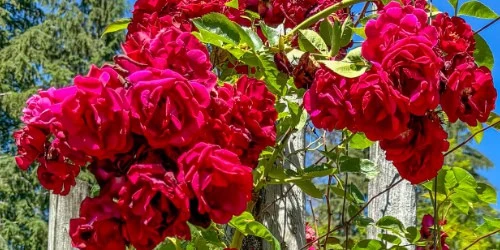
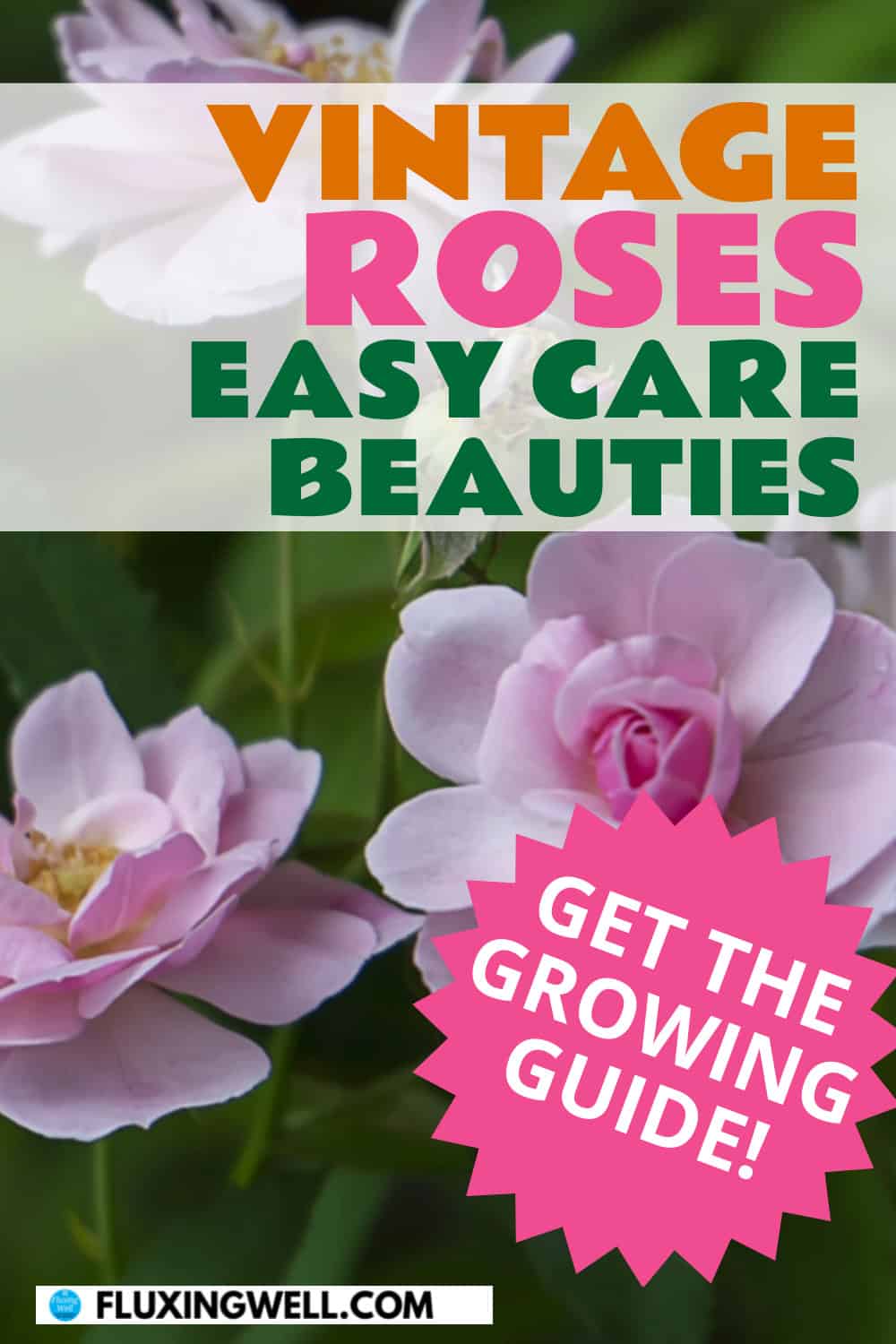
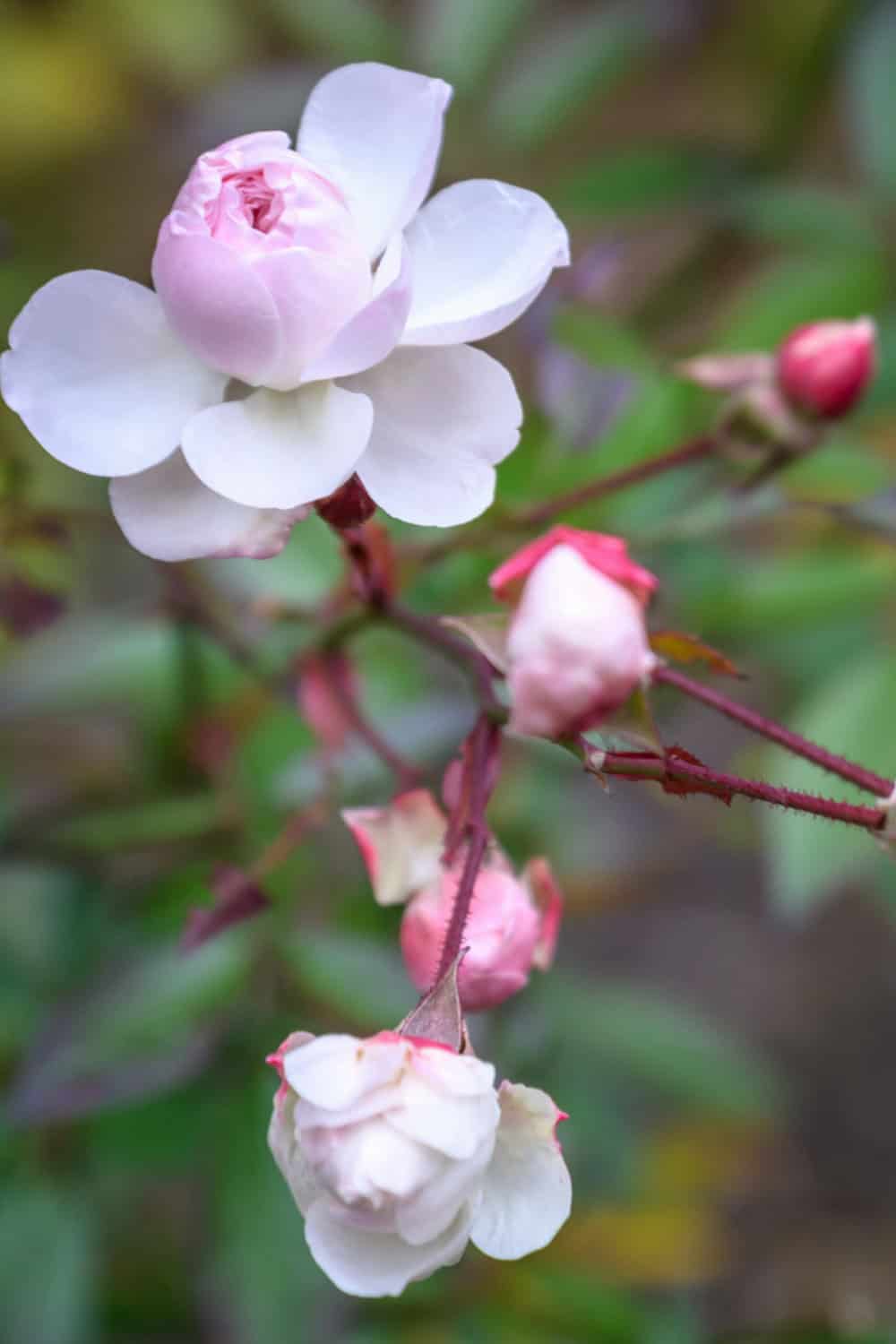
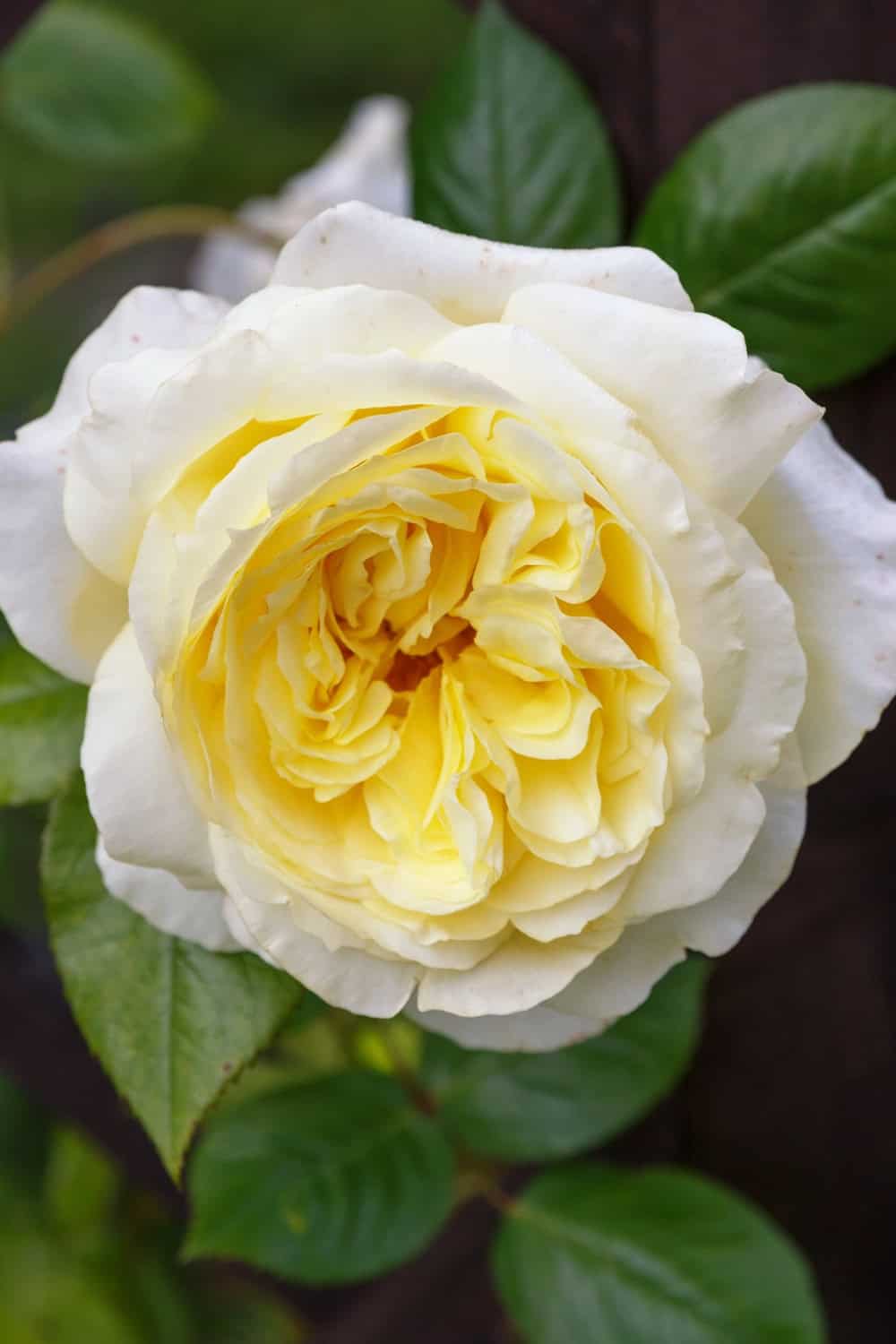
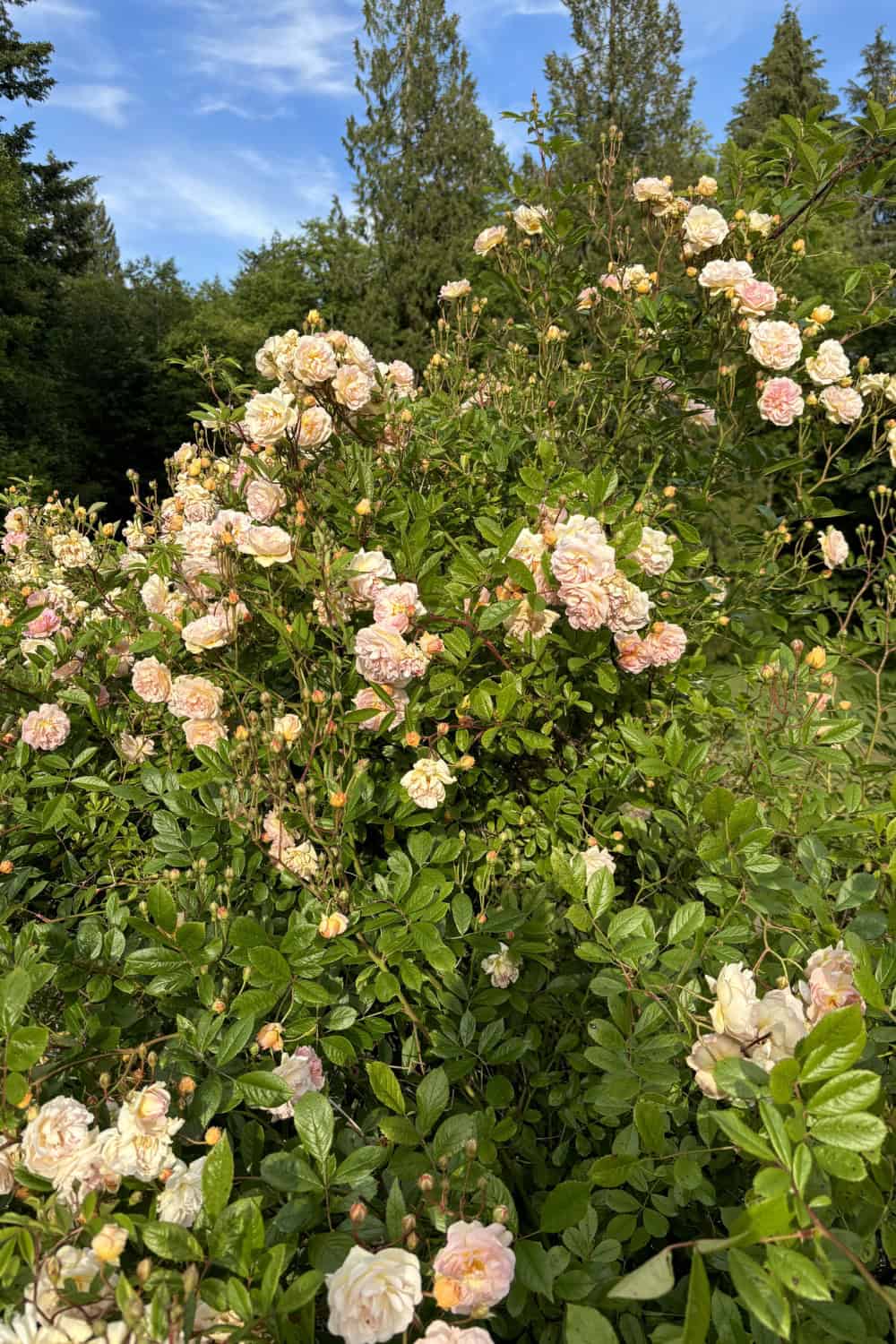
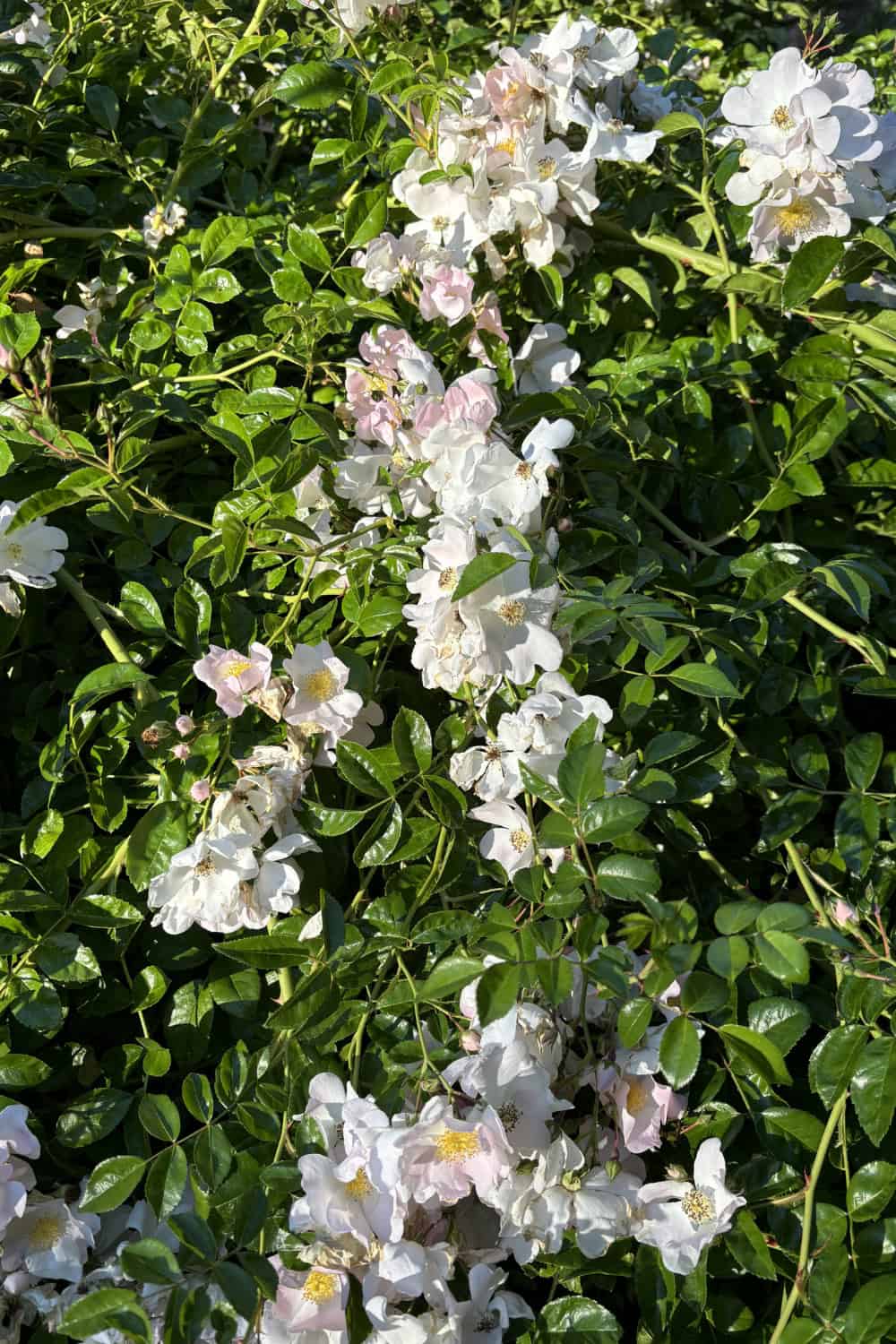
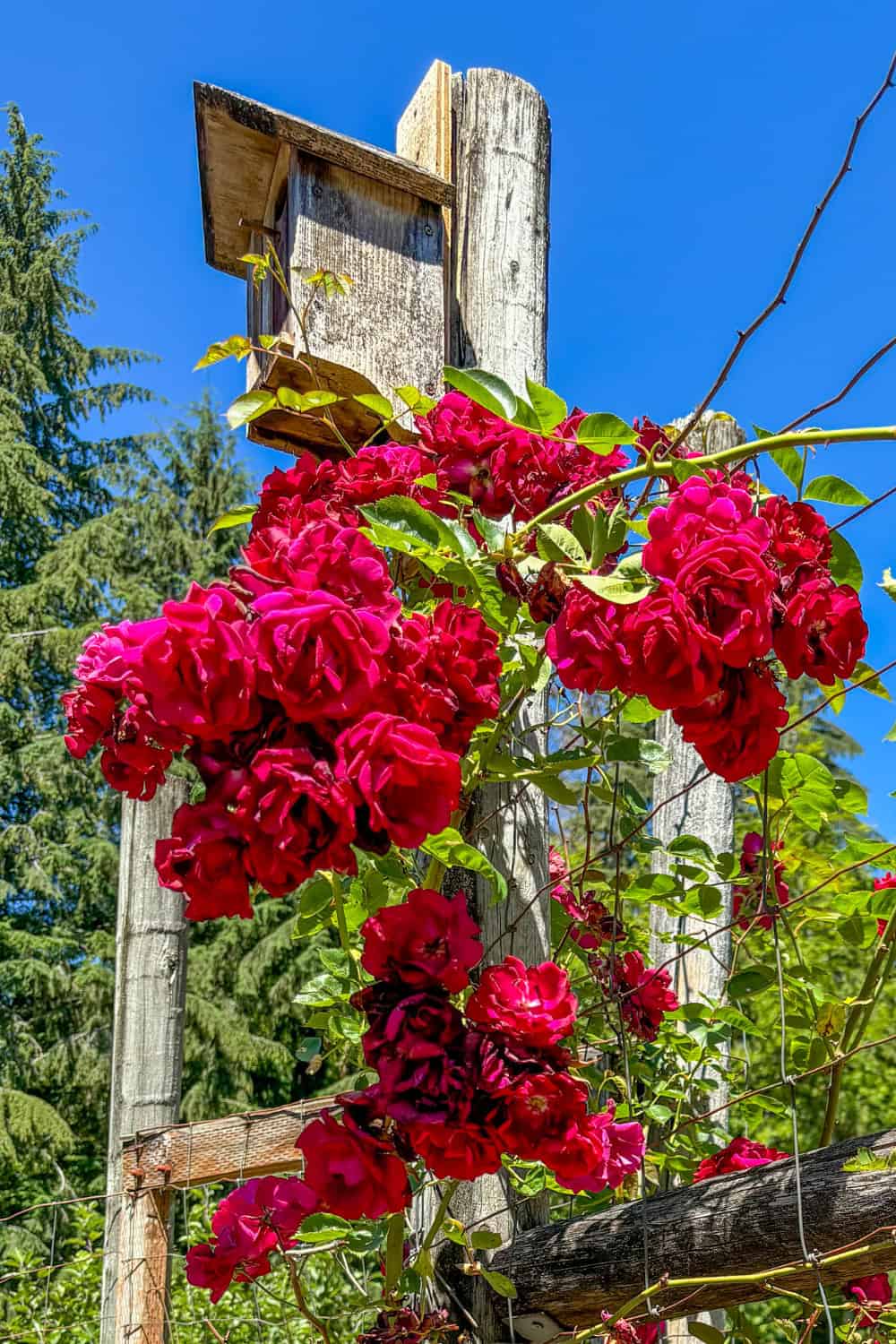


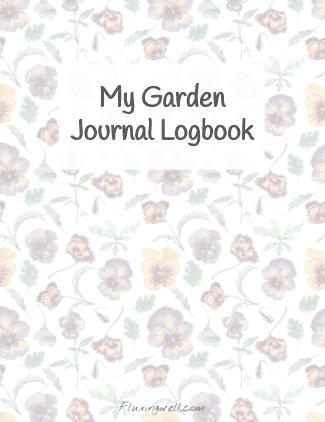

I have very poor luck with hybrid teas. I’ve done well with shrub roses, climbers, floribundas and antique roses.
I planted a hybrid tea a few years ago and basically forgot about it. I’m in northern Michigan and needless to say, it winter killed. However, it didn’t kill the root stock, which came back the following summer. I moved one 3 foot cane to a raised bed next to the front porch. It absolutely exploded with growth. I have no idea what it is, but this rose is pale pink, grows in clusters, fragrant and has canes over 16 feet tall. We just call it the monster rose. It is a real showstopper growing up the face of my barn red house.
Also, for those who may want a budget friendly rose that grows exceptionally well and blooms continously til frost, Climbing Blaze is a real beauty. Not really fragrant, but vigorous and beautiful.
Thank you for the recommendation and for sharing your amazing “monster rose” story. It’s great to learn that old garden heirloom roses can thrive in harsher growing conditions than what I have here in Zone 8b. What an inspiration! Happy rose-growing!
I dont mind the black spot or mildew.i am thankful no japenese beetles in seattle or i could not do roses.i have over 150 roses.all kinds.i love heirloom roses and the company.the antique rose emporium is another good place to buy roses.my problem right now is mountain beavers and rabbits.yard too big to put a fence .any ideas?
Hair? We used to sprinkle hair from our boys’ haircuts around and on our roses. That seemed to help. Wow! 150 roses! Well done!
Your garden looks beautiful. And tje roses are definitely going to be a great addition to it. I really like the mystery rose, I see it for the first time in my life. Thank you for the details! 💗
Monica,
I’m glad you liked the post. I am so grateful for roses like the Mystery Rose, which grows so well. Thanks for your comment, and good luck with all of your gardening plans.
Lisa
I love Heirloom Roses! Such beautiful gardens. My friend and I would visit every summer before attending the rodeo. I had quite a few of their roses planted in my front yard in Sandy. Thank you, Lisa, for the rose reminders- I must plant some here soon!:)
Jenny,
You were very generous to leave your roses behind when you moved. The people who live there are probably very grateful! Thanks for your comment, and have fun buying more roses from Heirloom Roses.
Lisa
I love Roses. They are the most of the ornamental plants in my garden. I love them especially when they bloom. Good luck with your rose garden.
Anthea,
I am enjoying the old garden roses right now, as they are in full bloom. The dahlias we planted in our old rose garden are doing well also. Thanks for commenting, and enjoy your roses!
Lisa
I love roses as well I never seen the “mystery rose” and I think it’s so beautiful. I love coming to your page because it gives me ideas for when I move into my house. I want to have a garden with flower and food. I have no clue where to start lol but your site is helpful. Thank you 🧡
Adrienne,
I’m so glad you think my site is helpful. I love it when people can use ideas they get from blog posts. Thanks for the kind words. You made my day!
Lisa
Girl I live in the desert and literally every plant I’ve ever had has died, including all cactus and succulents haha BUT, the only thing that comes back every single year is the 3 rose bushes I planted! They are one hardy plant!!
Jessie,
Thank you so much for affirming that old garden roses can grow anywhere! That is a great testimonial. I appreciate your comment, and hope you enjoy your roses this summer!
Lisa
Wow, so informative! I remember we tried growing roses when I was small, and the poor thing couldn’t even get past the pot. I love how you didnt give up on them.
Rio,
If you ever feel the need to plant roses again, maybe the old garden varieties would do better for you. Thanks for commenting, and I hope you can find a rose that will do well for you.
Lisa
I love how detailed this is. I know you’re talking about your garden BUT I literally could apply so many of your words to my life. Thank you!
Kimberly,
I often gain a lot of life wisdom from the garden. I’m glad that’s true for you as well. Thank you so much for the kind comment. I’m happy you enjoyed the post!
Lisa
Our landscaper put in roses for us last year. We are not gardeners and communicated that to him. He seems to believe we won’t kill them. 🤷🏽♀️ While I am not sure what kind they are, because there was so much rain this spring, we neglected to prune them. And now that summer has seemingly come in overnight, I am hesitant to touch them, because I don’t want to mess up. They seem to be doing okay and looked really pretty at the beginning of the season (except for those woody, dead branches jutted out from them). Should I wait until the fall now to try to prune them? Or is it okay to take the clippers to them now?
Vox,
It is definitely okay to trim off dead, woody branches and spent blooms, if you like. For the main pruning, in my area, the Pacific Northwest of the US, many people prune around President’s Day in February. As for how much to trim, here’s an article you might find helpful:
https://www.gardendesign.com/roses/pruning.html
Thanks for your comment, and good luck with your roses!
I love roses, especially the old varieties. I see the mystery rose all the time in my locality but I haven’t a clue what it’s name is; it most definitely grows and grows and grows!
The Mystery Rose is now is full bloom, and the fragrance just draws me in. It’s subtle, not overpowering, but so pleasant. Thanks for your comment! Maybe someday I’ll figure out the identity of the Mystery Rose. Have a great week!
Lisa